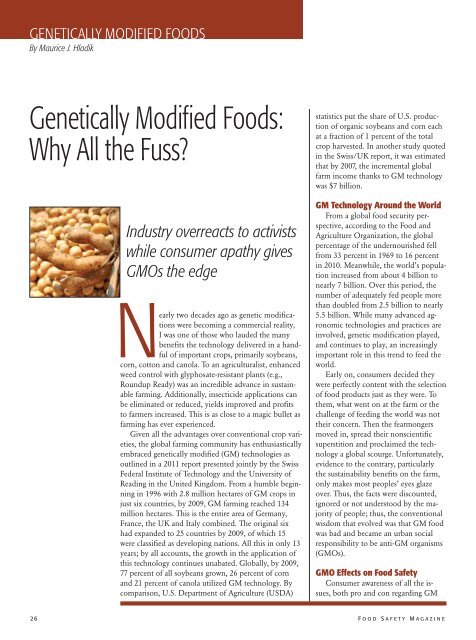Food Safety Magazine - June/July 2013
Food Safety Magazine - June/July 2013
Food Safety Magazine - June/July 2013
You also want an ePaper? Increase the reach of your titles
YUMPU automatically turns print PDFs into web optimized ePapers that Google loves.
genetically modified foods<br />
By Maurice J. Hladik<br />
Genetically Modified <strong>Food</strong>s:<br />
Why All the Fuss?<br />
Industry overreacts to activists<br />
while consumer apathy gives<br />
GMOs the edge<br />
Nearly two decades ago as genetic modifications<br />
were becoming a commercial reality,<br />
I was one of those who lauded the many<br />
benefits the technology delivered in a handful<br />
of important crops, primarily soybeans,<br />
corn, cotton and canola. To an agriculturalist, enhanced<br />
weed control with glyphosate-resistant plants (e.g.,<br />
Roundup Ready) was an incredible advance in sustainable<br />
farming. Additionally, insecticide applications can<br />
be eliminated or reduced, yields improved and profits<br />
to farmers increased. This is as close to a magic bullet as<br />
farming has ever experienced.<br />
Given all the advantages over conventional crop varieties,<br />
the global farming community has enthusiastically<br />
embraced genetically modified (GM) technologies as<br />
outlined in a 2011 report presented jointly by the Swiss<br />
Federal Institute of Technology and the University of<br />
Reading in the United Kingdom. From a humble beginning<br />
in 1996 with 2.8 million hectares of GM crops in<br />
just six countries, by 2009, GM farming reached 134<br />
million hectares. This is the entire area of Germany,<br />
France, the UK and Italy combined. The original six<br />
had expanded to 25 countries by 2009, of which 15<br />
were classified as developing nations. All this in only 13<br />
years; by all accounts, the growth in the application of<br />
this technology continues unabated. Globally, by 2009,<br />
77 percent of all soybeans grown, 26 percent of corn<br />
and 21 percent of canola utilized GM technology. By<br />
comparison, U.S. Department of Agriculture (USDA)<br />
statistics put the share of U.S. production<br />
of organic soybeans and corn each<br />
at a fraction of 1 percent of the total<br />
crop harvested. In another study quoted<br />
in the Swiss/UK report, it was estimated<br />
that by 2007, the incremental global<br />
farm income thanks to GM technology<br />
was $7 billion.<br />
GM Technology Around the World<br />
From a global food security perspective,<br />
according to the <strong>Food</strong> and<br />
Agriculture Organization, the global<br />
percentage of the undernourished fell<br />
from 33 percent in 1969 to 16 percent<br />
in 2010. Meanwhile, the world’s population<br />
increased from about 4 billion to<br />
nearly 7 billion. Over this period, the<br />
number of adequately fed people more<br />
than doubled from 2.5 billion to nearly<br />
5.5 billion. While many advanced agronomic<br />
technologies and practices are<br />
involved, genetic modification played,<br />
and continues to play, an increasingly<br />
important role in this trend to feed the<br />
world.<br />
Early on, consumers decided they<br />
were perfectly content with the selection<br />
of food products just as they were. To<br />
them, what went on at the farm or the<br />
challenge of feeding the world was not<br />
their concern. Then the fearmongers<br />
moved in, spread their nonscientific<br />
superstition and proclaimed the technology<br />
a global scourge. Unfortunately,<br />
evidence to the contrary, particularly<br />
the sustainability benefits on the farm,<br />
only makes most peoples’ eyes glaze<br />
over. Thus, the facts were discounted,<br />
ignored or not understood by the majority<br />
of people; thus, the conventional<br />
wisdom that evolved was that GM food<br />
was bad and became an urban social<br />
responsibility to be anti-GM organisms<br />
(GMOs).<br />
GMO Effects on <strong>Food</strong> <strong>Safety</strong><br />
Consumer awareness of all the issues,<br />
both pro and con regarding GM<br />
26 F o o d S a f e t y M a g a z i n e






![Otomatik indirilmez ise tıklayınız [Download]](https://img.yumpu.com/44170525/1/190x190/otomatik-indirilmez-ise-taklayanaz-download.jpg?quality=85)










